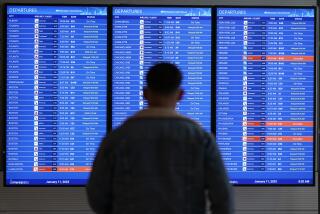Hedging losses drive UAL 4Q loss of $1.3 billion
- Share via
Two of the nation’s biggest airlines, battered by slumping demand for air travel, racked up huge losses and said Wednesday that they remained uncertain about profit prospects for 2009 amid a global economic downturn.
The dismal outlook hammered airline stocks. Shares of AMR Corp., parent of second-largest carrier American Airlines, dropped $2.48, or nearly 24%, to $7.98 after the airline reported that its fourth-quarter losses swelled to $340 million from $69 million a year earlier.
UAL Corp., parent of third-largest carrier United Airlines, posted a $1.3-billion loss in the quarter, compared with a loss of $53 million a year earlier. Its shares fell 71 cents, or 6%, to $10.91. The loss was less than what analysts were expecting.
The nation’s largest carrier, Delta Air Lines Inc., is scheduled to report its results Tuesday. American and United are the two busiest carriers at Los Angeles International Airport.
But airline woes may mean better fare deals for travelers looking to fly this spring or summer, when demand typically rises, industry observers said Wednesday. Fares are falling to levels not seen since the aftermath of the 9/11 terrorist attacks and could drop even lower, said Tom Parsons, chief executive of online travel guide Bestfares.com.
“I’m seeing some wacky stuff,” Parsons said, noting that Southwest Airlines and AirTran Airways began offering coast-to-coast fares of $99 one-way for travel up to the Memorial Day holiday.
This week, a fare war erupted for flights from LAX to Boston after upstart carrier Virgin America began offering an introductory fare of $298 round-trip. On Wednesday, a plane ticket to Boston fell to as low as $180 round-trip as carriers jockeyed for travelers.
Airlines are dropping fares because demand is still falling faster than cutbacks in available plane seats, said Joe Brancatelli, editor of business travel website joesentme.com.
The airlines “don’t have any pricing power at all,” he said. “I see continued flow of red ink for airlines and continued good fares for passengers.”
American said Wednesday that it planned to slash capacity, or the number of available seats, by 8.5% in the current quarter on top of the 8.3% it cut in the fourth quarter.
Demand for premium seats, typically the most profitable, are falling even faster as companies cut back on travel spending and require employees to book coach seats if they fly at all. In reporting its fourth-quarter results, United said traffic in its premium cabin -- first class and business class -- fell 25%.
With drop in overall demand, Chicago-based United said it would lay off 1,000 salaried and management staff by year-end, in addition to the 1,500 it had already announced.
Chief Executive Glenn Tilton told workers in an e-mail Wednesday that the layoffs were necessary because of reduced capacity and demand. United also was hurt by fuel hedges in which the airline locked in jet fuel prices when they were high.
Tilton said new fees such as those for baggage were expected to bring in $1.2 billion this year, up from $300 million in 2008. For all of 2008, United lost $5.35 billion, versus a year-earlier profit of $403 million. Revenue was nearly unchanged at $20.19 billion.
Fort Worth-based AMR swung to a loss of $2.1 billion in 2008 after posting profit of $504 million in 2007. New fees bolstered revenue by 3.6% to $23.8 billion.
--


